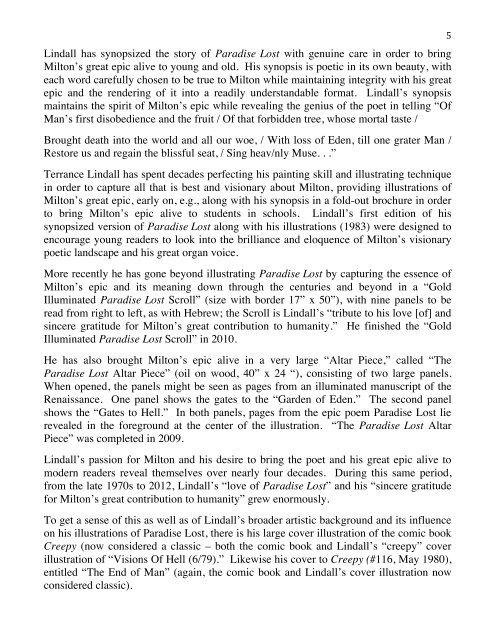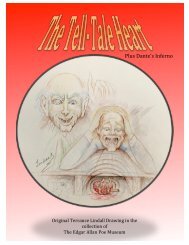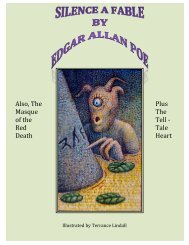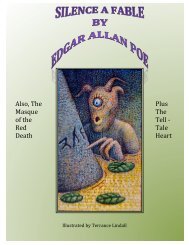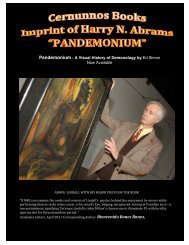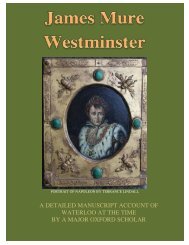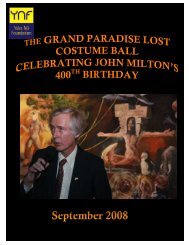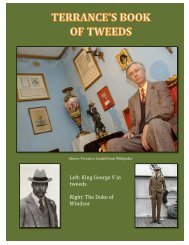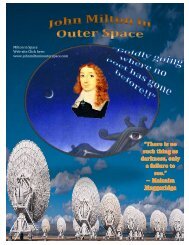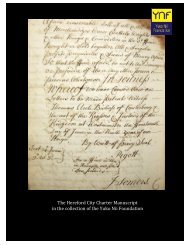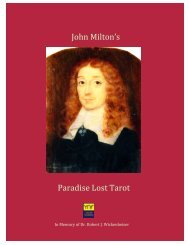The Acrostic Paradise Lost by John Milton and Terrance Lindall
The first ever acrostic that tells the story as the proem goes along. Contains most of Lindall's art for Paradise Lost. Signed and numbered hardcover is $300. milton@wahcenter.net
The first ever acrostic that tells the story as the proem goes along. Contains most of Lindall's art for Paradise Lost. Signed and numbered hardcover is $300. milton@wahcenter.net
Create successful ePaper yourself
Turn your PDF publications into a flip-book with our unique Google optimized e-Paper software.
! 5!<br />
<strong>Lindall</strong> has synopsized the story of <strong>Paradise</strong> <strong>Lost</strong> with genuine care in order to bring<br />
<strong>Milton</strong>’s great epic alive to young <strong>and</strong> old. His synopsis is poetic in its own beauty, with<br />
each word carefully chosen to be true to <strong>Milton</strong> while maintaining integrity with his great<br />
epic <strong>and</strong> the rendering of it into a readily underst<strong>and</strong>able format. <strong>Lindall</strong>’s synopsis<br />
maintains the spirit of <strong>Milton</strong>’s epic while revealing the genius of the poet in telling “Of<br />
Man’s first disobedience <strong>and</strong> the fruit / Of that forbidden tree, whose mortal taste /<br />
Brought death into the world <strong>and</strong> all our woe, / With loss of Eden, till one grater Man /<br />
Restore us <strong>and</strong> regain the blissful seat, / Sing heav/nly Muse. . .”<br />
<strong>Terrance</strong> <strong>Lindall</strong> has spent decades perfecting his painting skill <strong>and</strong> illustrating technique<br />
in order to capture all that is best <strong>and</strong> visionary about <strong>Milton</strong>, providing illustrations of<br />
<strong>Milton</strong>’s great epic, early on, e.g., along with his synopsis in a fold-out brochure in order<br />
to bring <strong>Milton</strong>’s epic alive to students in schools. <strong>Lindall</strong>’s first edition of his<br />
synopsized version of <strong>Paradise</strong> <strong>Lost</strong> along with his illustrations (1983) were designed to<br />
encourage young readers to look into the brilliance <strong>and</strong> eloquence of <strong>Milton</strong>’s visionary<br />
poetic l<strong>and</strong>scape <strong>and</strong> his great organ voice.<br />
More recently he has gone beyond illustrating <strong>Paradise</strong> <strong>Lost</strong> <strong>by</strong> capturing the essence of<br />
<strong>Milton</strong>’s epic <strong>and</strong> its meaning down through the centuries <strong>and</strong> beyond in a “Gold<br />
Illuminated <strong>Paradise</strong> <strong>Lost</strong> Scroll” (size with border 17” x 50”), with nine panels to be<br />
read from right to left, as with Hebrew; the Scroll is <strong>Lindall</strong>’s “tribute to his love [of] <strong>and</strong><br />
sincere gratitude for <strong>Milton</strong>’s great contribution to humanity.” He finished the “Gold<br />
Illuminated <strong>Paradise</strong> <strong>Lost</strong> Scroll” in 2010.<br />
He has also brought <strong>Milton</strong>’s epic alive in a very large “Altar Piece,” called “<strong>The</strong><br />
<strong>Paradise</strong> <strong>Lost</strong> Altar Piece” (oil on wood, 40” x 24 “), consisting of two large panels.<br />
When opened, the panels might be seen as pages from an illuminated manuscript of the<br />
Renaissance. One panel shows the gates to the “Garden of Eden.” <strong>The</strong> second panel<br />
shows the “Gates to Hell.” In both panels, pages from the epic poem <strong>Paradise</strong> <strong>Lost</strong> lie<br />
revealed in the foreground at the center of the illustration. “<strong>The</strong> <strong>Paradise</strong> <strong>Lost</strong> Altar<br />
Piece” was completed in 2009.<br />
<strong>Lindall</strong>’s passion for <strong>Milton</strong> <strong>and</strong> his desire to bring the poet <strong>and</strong> his great epic alive to<br />
modern readers reveal themselves over nearly four decades. During this same period,<br />
from the late 1970s to 2012, <strong>Lindall</strong>’s “love of <strong>Paradise</strong> <strong>Lost</strong>” <strong>and</strong> his “sincere gratitude<br />
for <strong>Milton</strong>’s great contribution to humanity” grew enormously.<br />
To get a sense of this as well as of <strong>Lindall</strong>’s broader artistic background <strong>and</strong> its influence<br />
on his illustrations of <strong>Paradise</strong> <strong>Lost</strong>, there is his large cover illustration of the comic book<br />
Creepy (now considered a classic – both the comic book <strong>and</strong> <strong>Lindall</strong>’s “creepy” cover<br />
illustration of “Visions Of Hell (6/79).” Likewise his cover to Creepy (#116, May 1980),<br />
entitled “<strong>The</strong> End of Man” (again, the comic book <strong>and</strong> <strong>Lindall</strong>’s cover illustration now<br />
considered classic).


